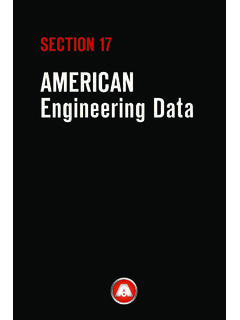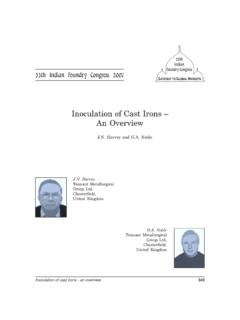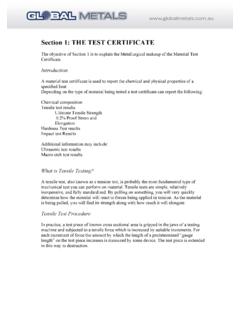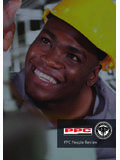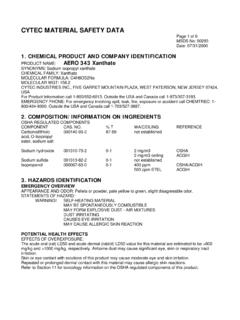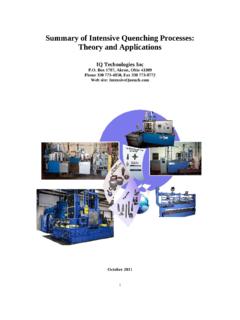Transcription of Section Two: Steel Pipe Design - AMERICAN
1 Section Two: Steel pipe DesignSPIRALWELD PIPEAMERICAN SpiralWeld pipe Company, LLC ( AMERICAN ), located in Columbia, South Carolina, manufactures the highest quality spiral-welded Steel pipe available (see Section 1 Introduction for more detail). In a 290,000 square-foot production facility equipped with the latest technology, AMERICAN produces the pipe to meet or exceed the requirements of applicable AMERICAN Water Works Associa-tion (AWWA) and AMERICAN Society for Testing and Materials (ASTM) standards.
2 The inherent properties of the Steel from which spiral-weld-ed pipe is formed result in a strong and adapt-able product. It is important that the designer understands these properties and how they affect the Design of Steel - Mechanical PropertiesModern Steel making processes have resulted in excellent grain structure and control of the me-chanical properties. These properties include mini-mum yield strength, minimum tensile strength, elongation (measure of ductility), impact strength, and hardness.
3 AMERICAN is capable of forming spiral-welded Steel pipe from Steel that has a maxi-mum yield strength up to 70 ksi. However, for typi-cal water and wastewater applications, minimum yield strengths between 35 ksi and 52 ksi are more common. This flexibility offers customers an ability to optimize pressure and structural BenefitsSome benefits of Steel pipe include material properties; adaptability to different applications such as water and wastewater transmission, pump station and treatment plant piping, circulating water lines for the power industry, penstocks, intakes and outfalls, aerial crossings, aqueducts, and trenchless; flexibility of flow and pressures by varying sizes and wall thicknesses.
4 And the ability to provide a simple basis for OverviewThe basic criterion for the Design of a Steel pipe is resistance to internal pressure. Once that criterion has been met, the resulting wall thickness is verified for adequacy with respect to other performance criteria such as: External loads Handling Buckling (external pressure)For many projects, the wall thickness recommended to allow reasonable handling of the pipe satis-fies the remaining performance criteria as well. AWWA Manual M11, Steel Water pipe : A Guide for Design and Installation, and AMERICAN Iron and Steel Institute s Welded Steel pipe Design Manual provide excellent information for the Design PrinciplesTypically, water pipe should be designed based on the in-ternal working and transient pressure service conditions to which it will be subjected during its lifetime.
5 Additional service conditions to evaluate include external operating and transient or live load, and vacuum pressures. In ad-dition, adequate stiffness is needed for ease of handling pipe in the facility and in the field. The following guide-lines focus on the Design and calculation of the required pipe wall thickness based on these service plate and sheet manufacturers today produce very high quality Steel using the continuous casting process. This process yields a fine grain, killed (deoxidized) Steel that is metallurgical-ly homogeneous and exhibits excellent ductility.
6 Steel pipe is typically manufactured from one of several steels available in varying strengths as listed in Table Typically, higher strength Steel has a marginally higher cost. For applications where the operating or Design pressure exceeds 175 psi ( MPa), an analysis should be performed to evaluate the potential cost or other advantages of using Steel with yield strength in excess of 42 ksi (290 MPa). For the same pressure requirements, the increase in cost for using a higher strength material is typically less than the costs associated with the increased wall thickness required for a lesser strength Steel .
7 The use of higher strength Steel normally has little benefit, though, for lower pressure, buried applications. In low-pressure designs, handling or other considerations rather than internal pressure will most often govern the selection of the pipe wall Sheet (Coil or Flat) A139 B 35 (242) 60 (415) C 42 (290) 60 (415) D 46 (315) 60 (415) E 52 (360) 66 (455) Steel Plate A36/A36M 36 (248) 58 (400)
8 A572/A572M 42 42 (290) 60 (415) 50 50 (345) 65 (449) A516/A516M 55 30 (205) 55 (380) 60 32 (220) 60 (415) 65 35 (240) 65 (450) 70 38 (260) 70 (485)1 Other Steel material types, including various grades of ASTM A1011 or ASTM A1018, are available upon request. Contact an AMERICAN representative for availability of a particular Steel material type not listed above.
9 When designing a Steel pipe , the main Design consideration is the pipe s ability to withstand internal pressure. After a wall thickness has been determined based on internal pressure, including both operating and transient pressures, that thickness must be checked to determine its adequacy for resisting external loads and the minimum thickness required for handling. External loads include those due to backfill material and potential vehicles, construction equipment, or railroad cars, and buckling forces resulting from external pressure.
10 As required, the composite wall thickness for non-buried pipe ( Steel thickness plus cement lining thickness, when applicable) can be increased; or, for buried Steel pipe , the stiffness of the pipe /backfill system can be increased to resist the external loads. The most common and cost effective method used to increase the pipe /backfill system stiff-ness is to improve the quality of the backfill material and/or the level of backfill MaterialDesignation1 GradeMinimum Yield Strength ksi (MPa)Minimum Tensile Strength ksi (MPa)4 Internal PressureDesign for internal pressure requires a two-part stress analysis.
